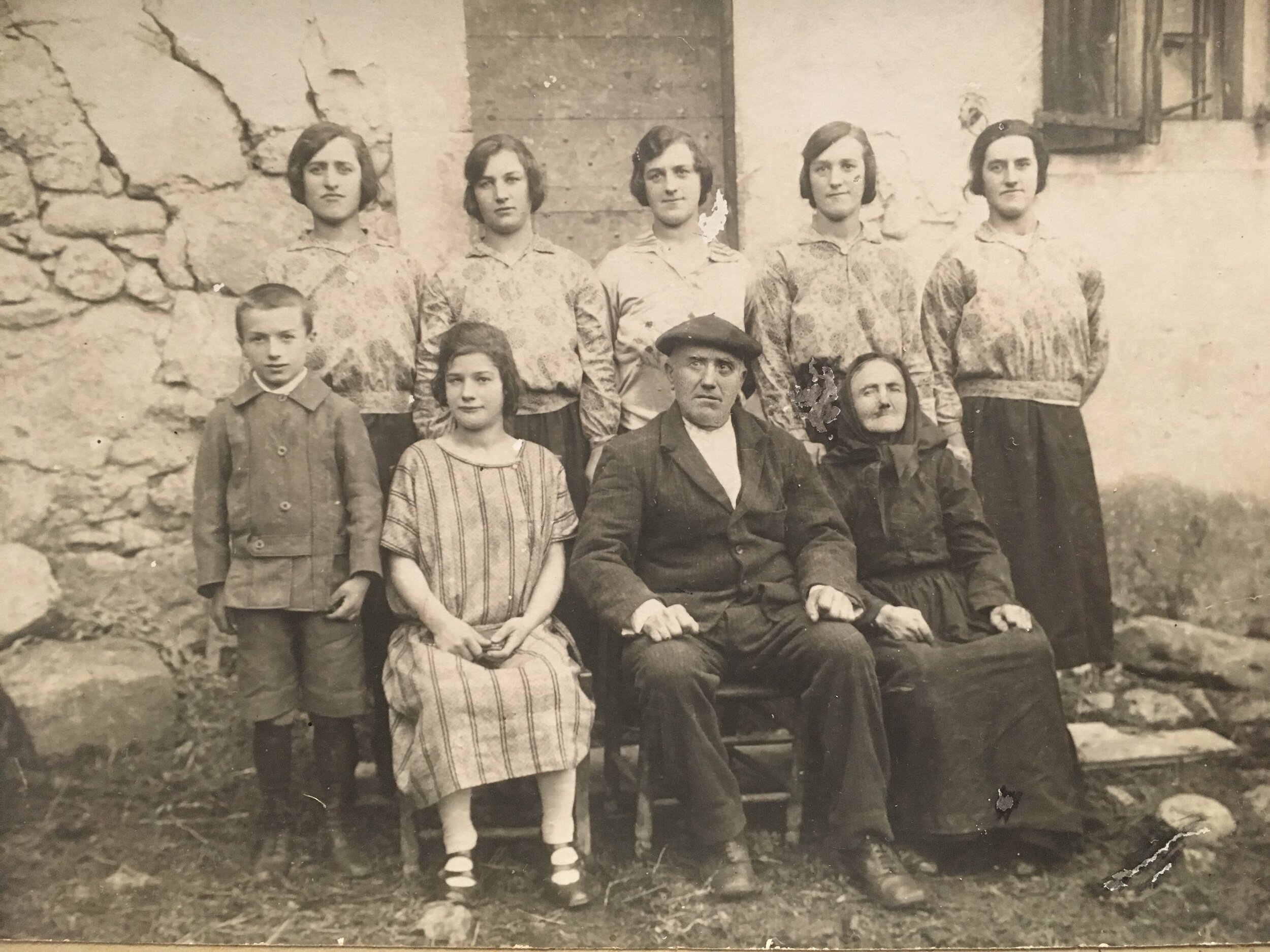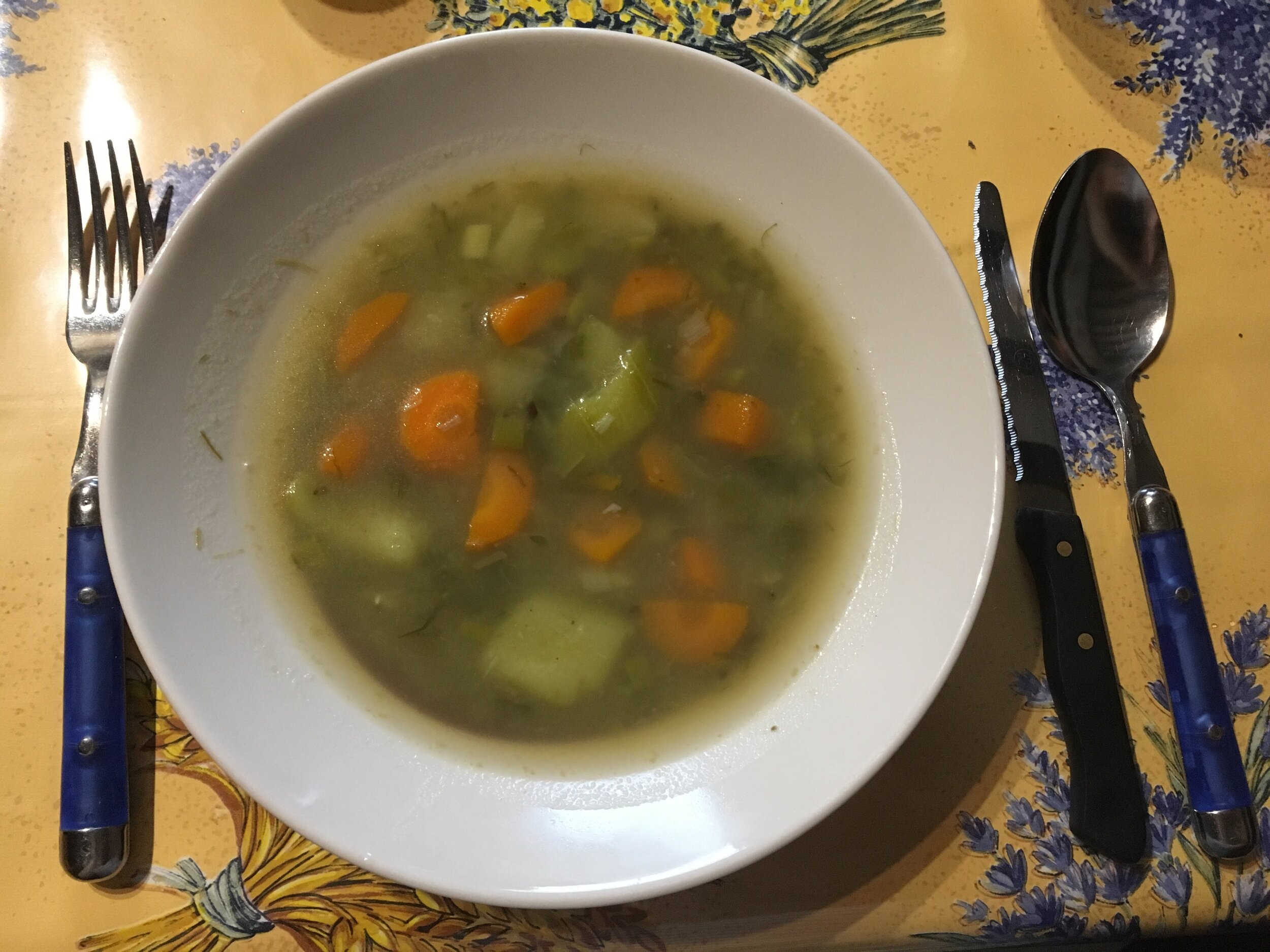French Peasant Potage
My Grandma’s Vegetable Soup
Both grandparents on my dad’s side grew up in rural France. Their families raised sheep (Grandpa) and cows (Grandma), and subsisted as best they could with no money or birth control. They were truly – to translate directly from the French word they used to describe themselves – peasants.
Grandma Bourdet is back row, far left, and looking fierce.
The view from my grandmother’s childhood home
After my grandparents came to America and got married, they went back to raising their own food as soon as they had land to do it. My grandmother’s vegetable garden was full of mysterious (to me, as a small American child) leaves and stems and fronds. She had fresh onions, leeks, garlic, potatoes, beets, asparagus, artichokes, radishes, watercress, lettuce, “doucette” (lamb’s lettuce/mâche), green chard, rainbow chard, tomatoes, string beans, Italian peppers, winter squash, thyme, parsley, rosemary, apples, peaches, figs, apricots, walnuts, chestnuts, plum, quince, and pears just steps from the house – with rabbits, chickens, ducks, pigeons, pheasants, doves and bees in the backyard.
With all that bounty, she made a phenomenal vegetable soup. My aunt says that growing up, if they didn’t have homemade chicken broth, she and my dad would eat this soup every day for lunch and dinner – even in the hot summer months. They’d make a big pot on Sundays to last them through the week.
For the longest time I thought Grandma had invented this soup as the family staple, but it turns out pretty much everyone in the country town she and my grandpa grew up in makes a version of it. The proportions vary from cook to cook, and everyone’s got their little trick they do, but the core is always the same:
Water. Salt. Leeks. Carrots. Thyme. Potatoes.
Boil everything together 20 minutes with a spoonful of something rich, and serve.
That’s it.
Hard to imagine a more humble dish. And yet, a lot of times, a bowl of this with a hunk of cheese and bread is dinner – for my older relatives in France, and now me as well.
My grandmother expanded on the classic recipe with homegrown green chard and winter squash, with a bit of salt pork or bacon grease for richness. It’s a fabulous mix of textures and flavors, a little sweet from the squash and carrots, a little earthy from the chard and potatoes. There’s more chopping involved, but also more color, flavor, and nutrition. In my memories, the root vegetables were always mashed up pretty well by the time they got to my soup bowl, but my aunt says they’d more typically leave them whole and let each person mash things up in their bowl, if they wanted to.
Monique, my first cousin once removed (who still lives on the property her mom and my grandma grew up on), makes a minimalist version. Since her husband Paul hates all vegetables besides potatoes, her soup has one lonely piece of leek green, a tiny bit of carrot, about five beans and a ton of potatoes from their garden. She never mashes up the veggies before serving from the pot, so Paul can more easily avoid the non-potato items (he says he’s “leaving them for the others”). Monique does add a bit of store-bought spicy cayenne, though, to give it a kick, and a tablespoon of jus from yesterday’s roast, if there’s any left.
Monique’s version (for people other than Paul)
All the versions of this soup that I’ve tried are delicious, healthy, and cost next to nothing if you’re a peasant with a potager garden. Store-bought vegetables aren’t nearly as cheap or tasty as the ones freshly dug from the garden, but farmers’ market produce makes a pretty fantastic substitute.
I’ve eaten my grandma’s recipe the most, so that’s the version I’m sharing a recipe for here. I’ve taken a few liberties from her original, however. Like Monique, Grandma Bourdet would start the soup by boiling water while she peeled and chopped, and then put the veggies directly into the water to cook. I prefer to sweat the leeks a bit first to concentrate their flavor before I add the water. My grandmother also used to save the chard stems and pan fry them breaded in crushed crackers, but I like to slice them up and use them in the soup with the greens. They taste like an interesting celery.
To make the fresh thyme branches easier to remove at the end, Grandma (and Monique, too) would tie a string around the sprigs to keep track of them. Here, I suggest just stripping the leaves off right at the beginning so there are no stems to worry about at all.
Finally, instead of salt pork or bacon grease, I usually drizzle a teaspoon or two of extra virgin olive oil over each bowl right before you eat it. It adds a fresh, zippy lift and helps round out the soup texture. I also recently started seasoning my soup with a little bit of Vietnamese fish sauce (I like Three Crabs brand and Red Boat the best) to bring the umami. Obviously neither of these finishing touches is traditional, but they have the same effect as the bacon grease, salt pork, and meat jus: a subtle, savory richness that’s exactly what you want in a comforting bowl of soup. If you want a more traditional Southwestern French flavor, use duck or goose fat to cook the veggies.
All measurements below are approximate, so it’s fine to put a little more or less based on what you’ve got. If you don’t have butternut squash, just triple the carrots. If you don’t have chard, use a half-pound of spinach or beet greens and don’t worry about it.
This soup pairs great with a glass of rustic red plonk, or any red wine you enjoy. Don’t forget the bread and cheese, either – my favorite from the old country is called P’tit Basque, and you can buy it at Costco, Whole Foods, and most stores with a good cheese department.
Grandma’s Potager Soup
(À MA FAÇON)
Makes about 5 quarts
8 cups water
3 Tbsp butter or olive oil
2 leeks (or 1 large)
1 bunch green/Swiss chard (1 pound)
2-3 carrots (½ pound)
2-3 Yukon gold potatoes (1 pound)
3 cups butternut squash (1 pound)
2 tsp fresh thyme leaves (or ½ tsp dried thyme)
Sea salt, pepper
Extra virgin olive oil
Vietnamese fish sauce
Bring 8 cups of water to a simmer. While you’re waiting, clean the leeks (here’s a video). Trim off the base and any yucky leaves, rinse them carefully to remove all the sand, then slice crosswise – I use both the white portions as well as any light green parts that aren’t tough or stringy. Save any tough, dark green leaves in the freezer for a bouquet garni whenever you need it.
Wash the chard well, making sure you get any dirt off the white ribs as well as the nooks and crannies of the leaves. Cut out the ribs from the leaves, trim the base of each rib, and slice it crosswise like you did the leeks. Roughly chop the green leaves into ribbons about one-inch wide.
Peel the carrots and potatoes, and cut into big (two-inch+) chunks. Peel the butternut squash and cut it the same way.
In a big pot (at least 6L and different from the one you’ve got your water in), melt the butter/warm the oil. Stir in the sliced leeks, chard stems, and thyme with a big pinch of salt, and sauté a few minutes to “sweat” the vegetables. Cook until they lose at least a third of their volume, stirring occasionally. Add the carrots, potatoes, butternut squash and chard leaves, cover the vegetables with the hot water (adding more if necessary), and add two teaspoons of sea salt. Cover the soup pot, bring it up to the boil, then let it simmer for at least 20 minutes.
When the carrots, potatoes, and squash are tender, turn off the heat and use a potato masher to crush them up in the pot. Taste for seasoning, and add salt and pepper to taste.
Drizzle each bowl with 1-2 teaspoons extra virgin olive oil and a few drops of fish sauce, and serve – with crusty bread and sheep cheese, if you’ve got it.
My Version
My Aunt Rosie’s Version
My Cousin Monique’s Version








